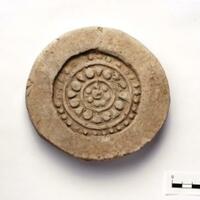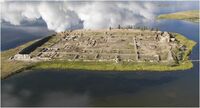Por-Bajin
Type:
Monasteries
Date:
777
Location or Findspot (Modern-Day Country):
Russia
Description:
A lake island in the Sengelen mountains of southern Siberia, near the modern-day Russian border with Mongolia, is the site of a ruined Manichaean monastery. Carbon-14 dating techniques used on a wooden beam from the site have recently helped assign it a date of 777. Other archaeological finds include faded images on the plaster walls, a single silver earring with a pendant, a tile with an apotropaic dragon image, and fragments from three to four ceramic vessels. Despite these finds, there is little evidence of human presence on the island.
The monastery was built during the rule of Bügü Khan (r. 759-79), the third khagan of the Uyghur Khaganate. Under the influence of Sogdian Manichaeans, Bügü Khan converted to Manichaeism and adopted it as the state religion. He and his Sogdian advisors were eventually executed during an anti-Manichaean rebellion in 779, which helps to explain why the heavily fortified monastery was built but seemingly never occupied.
The monastery was built during the rule of Bügü Khan (r. 759-79), the third khagan of the Uyghur Khaganate. Under the influence of Sogdian Manichaeans, Bügü Khan converted to Manichaeism and adopted it as the state religion. He and his Sogdian advisors were eventually executed during an anti-Manichaean rebellion in 779, which helps to explain why the heavily fortified monastery was built but seemingly never occupied.
Relevant Textbook Chapter(s):
4
Repository and Online Resources:
• Read more about Por-Bajin on the website of The Siberian Times.
Image Credits:
Andrei Panin, Wikimedia Commons




